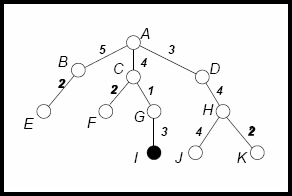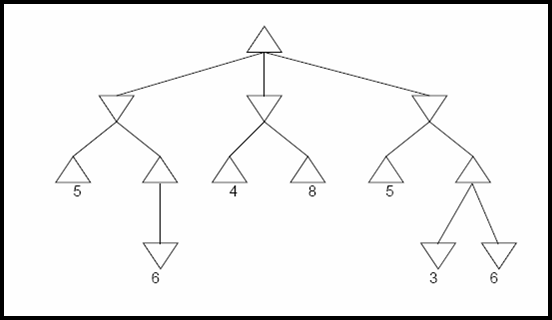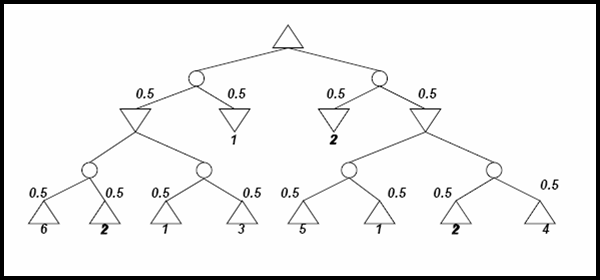Material
The material covered in this midterm consists of the following chapters and sections in the textbook:- Chapter 2, all sections .
- Chapter 3, all sections except 3.6.
- Chapter 4, sections 4.1 and 4.2.
- Chapter 6, all sections except 6.6.
- Chapter 7, sections 7.1, 7.2, 7.3, 7.4, 7.5 up to and NOT INCLUDING the "forward and backward chaining" subsection, which starts on page 217.
Practice Questions
- For each of the following agent environments, decide if it is fully or partially observable, deterministic or stochastic, static or dynamic, and discrete or continuous:
- playing poker.
- robot soccer player.
- autonomous Mars rover
- playing tic-tac-toe.
- mathematician's theorem-proving assistant.
- Suppose that an agent lives in a grid world of size 5 x 5 (for a total of 25 squares). The agent
has two sensors: a GPS sensor, which informs the agent of its current location on the grid,
and a camera sensor, which informs the agent of the color on the current square and the four adjacent squares. The agent, at each step, moves left, right, top, bottom. 24 of the 25 squares are safe, and one square (at location 4,3) is dangerous. The current location of the agent is safe.
a. If the agent is reflex-based, the safe squares are green, and the dangerous square is red, is it possible for this agent to follow a safe strategy that will always avoid the dangerous square? If yes, what is that strategy?
b. If the agent is reflex-based, and all squares (safe and dangerous) are green, is it possible for this agent to follow a safe strategy that will always avoid the dangerous square? If yes, what is that strategy?
- For the following tree, show the order of nodes visited for
breadth-first search, depth-first search, uniform cost search, and iterative deepening search . The goal node is I and the numbers
next to the edges indicate the associated cost.

- Does a finite state space always lead to a finite search tree? Justify your answer.
- Textbook exercise 3.8, parts (a) and (b).
- (harder) Describe a state space with 5 states, where the number of nodes visited by iterative deepening search (including the start node) is 15.
- Suppose that we are given a roadmap of the United States (i.e., we are given a list of roads, such that each road directly connects two cities). Additionally, we are given the distance from every city to Chicago. Consider the following heuristic (for possible use with A*): for each city A, h(A) = distance from A to Chicago + distance from Chicago to the goal. Is this heuristic admissible? Justify your answer.
- (harder) An agent lives in a grid world of size 10 x 10. The goal of the agent is to
find a rose. At every step, the agent can move left, right, up, or down. The agent
has a sensor that detects the smell at the current square, and another sensor that
detects if the current square contains a rose. Any square having distance 3 steps or
less from a rose smells nicely, all other squares smell badly. Use this information
to define a maximal admissible heuristic for this search problem (i.e., a heuristic that
is not dominated by any other admissible heuristic that can be defined using this knowledge).
- What is the number of possible SOS board states for a board with m rows and n columns?
You do not have to state the number explicitly, but you have to give a simple expression for it (that can include +, -, *, /, !, and exponentiation).
- Perform minimax search with alpha-beta pruning for the following game tree. Indicate which
nodes are never visited and which branches are pruned (assuming that ties are broken strictly
from left to right ). Also indicate next to each node its computed value or an upper/lower bound
for that value, as computed during the search.. The utilities of terminal nodes are indicated below the leaf nodes.

- Determine the values of all nodes in the following game tree with chance nodes using Expectiminimax.
The utilities of terminal nodes are indicated below the leaf nodes and the probabilities
of chance nodes are next to the corresponding branches.

- (harder) Albus Einstein (great grandson of Albert Einstein) has invented a computer with infinite memory, although, unfortunately, not infinite speed. Describe how to use/modify a minimax-based chess- playing program, using this computer, to make sure that the search always terminates and always produces an optimal strategy.
- Convert the following knowledge base to conjunctive normal form:
A AND B B => (A OR C)
- Consider the following knowledge base:
A B NOT A
Does this knowledge base entail the following sentence:B OR C
Justify your answer. - Textbook exercise 7.5.
- (harder) Textbook exercise 7.6.a
- Textbook exercise 7.8.
- For some sentence S involving literals A, B, C, here is the truth table:
Give a conjunctive normal form for sentence S.A B C Sentence false false false true false false true false false true false false false true true true true false false false true false true false true true false false true true true true